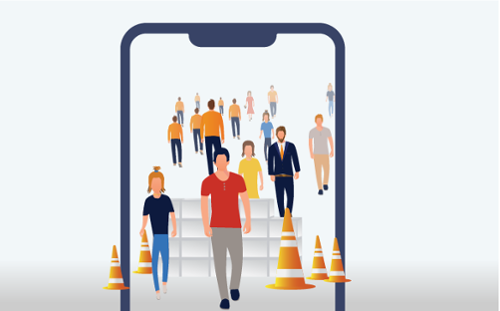Southwest Financial Federal Credit Union discusses how members are accepting this new more personal channel of communication.
Southwest Financial Federal Credit Union discusses how video banking is a comprehensive solution that can be implemented in a number of different ways.
Southwest Financial Federal Credit Union describes how video banking can help you reduce loan loss among new and prospective members.
Texas Tech describes why they chose video banking, and what it means for their strategy moving forward.

Mobile channels are supposed to improve convenience, but most mobile banking apps have fallen flat. According to a recent Magnify Money report published in The Financial Brand, consumers gave mobile banking apps an average rating of 3.7 out of 5, a merely average 74% score.
The culprit is friction – all of that red tape that kills convenience. Eliminating friction is the primary objective of POPi/o Mobile Video Cloud’s video banking solution. We’ve been thrilled to hear how our clients have utilized mobile video to reduce friction and create a better experience that builds sales and brand loyalty.
Here are four common convenience killers and ways mobile video can eliminate them.
#1 Onboarding
We’ve all seen the dismal online and mobile loan application abandonment rates, which can be as high as 98%. When Southwest Financial FCU launched POPi/o in September 2017, its primary goal was to increase loan volume by decreasing friction in the lending process due to the credit union’s largely remote membership. In particular, Southwest Financial was still asking consumers to fax signed loan documents to complete applications. The result was a frustrating 80% loan application abandonment rate. Consumers were put off by the inconvenient process, and employees were wasting time calling to follow up on docs that never arrived. With POPi/o video banking, loan apps are signed, sealed and delivered with just one call.
#2 Authentication
Wire fraud is a big problem for financial institutions, with losses at mid-sized banks and credit unions running as high as tens of thousands of dollars per month. In July, the FBI issued an alert warning against a new scam in which a bad actor accesses a legitimate email account to request unauthorized wire transfers. The FBI reported that there have been more than 41,000 victims in the U.S. alone, accounting for a total of $3 billion in fraudulent wire transfers. Many of our clients use video banking to verify wire transfers. Not only does video banking make verification compliance more convenient for consumers, the institution can also use facial identification to confirm it’s really their consumer requesting the transaction.
Download FREE Benefits of Video Banking Article
#3 Navigation
As consumers, we’ve all experienced poorly designed apps that aren’t intuitively organized and don’t provide the information we need. We may spend a few moments trying to navigate around the app to find what we want, but it doesn’t take long before we abandon the effort. Video banking isn’t an end-all solution for a poorly designed banking app, but it can reduce friction by providing quick and easy access to subject matter experts. South Bay Credit Union uses POPi/o video banking to provide fast, face-to-face access with experts, who may be located centrally or in a branch. No matter where consumers are, they can connect instantly, with no navigational friction involved.
#4 Communication
Taking navigation one step further, if a consumer experiences a technical problem or questions a transaction using a mobile banking app, immediate access to a service representative isn’t always available. POPi/o Video Banking not only provides immediate face-to-face service, representatives can utilize the app’s screenshare feature. This enables your employees to show – not just tell – consumers how to resolve issues. POPi/o Video Banking is also very helpful when assisting consumers who don’t speak English. Pioneer Federal Credit Union uses POPi/o Video Banking to assist Spanish speaking members, who often want branch service but sometimes arrive to find no bilingual employee on duty. Video banking allows the credit union to draw upon its centralized staff to quickly find a bilingual employee, providing clear communication to non-English speakers in any branch, or wherever they may be.
What happens next? You slay even more.
POPi/o Video Banking eliminates nearly all mobile convenience killers. Our bank and credit union clients continue to impress us with the innovative ways they’re using our solution to reduce friction and improve their consumer experience. If your brand loyalty is on the ropes because of a convenience killer, give us a call. We can bring your mobile service experience back to life.
Texas Tech describes what they learned from their member focus group surrounding mobile video banking.
Texas Tech describes what members are saying when using the POPi/o Video Banking Collaboration platform.
Texas Tech describes what they like most about the POPi/o Video Banking Collaboration platform.
Texas Tech demonstrates how they can serve a broad scope of requests and still provide excellent service through video banking.
Texas Tech describes what they would want other FI’s to know if they were thinking about implementing mobile video banking.
Luke Campbell, VP of Sales & Service, at Southwest Financial Federal Credit Union and Gene Pranger, inventor of video banking, discuss how Southwest rolled out their video solution to membership.
Tracey Miller, VP of Branch Operations Pioneer Federal Credit Union, and Gene Pranger, inventor of video banking, discuss the process Pioneer went through when implementing POPi/o.
Tracey Miller, VP of Branch Operations Pioneer Federal Credit Union, discusses how video banking can be sold internally.
Scott Fieber, VP Strategic Solutions, at Cook Security Group and Gene Pranger, inventor of video banking, discuss the next generation of convenience that millennials are encouraging throughout financial service offerings.
Tracey Miller of Pioneer Federal Credit Union describes the convenience of mobile video banking.
South Bay Credit Union discusses the pricing of POPi/o and the low barrier to getting started.
Southwest Financial Federal Credit Union describes their goals with video banking
Texas Tech describes how POPi/o Video Banking Collaboration is affordable for all financial institutions.

For months, financial services leaders have been wondering if Amazon will enter the mortgage market. Perhaps they’re asking the wrong question.
Whether or not Amazon offers mortgages doesn’t even matter because Quicken Loans’ Rocket Mortgage has already upended the financial services market. Quicken Loans is currently the nation’s top mortgage lender by volume, originating $20.5 billion in the first quarter of 2018. Rocket Mortgage not only streamlined the application process to eight minutes, it has reduced closing time on purchases to just 16 days.
Quicken Loans isn’t the only mortgage lender that has reduced friction for borrowers. In fact, so many lenders provide such an advanced mortgage lending experience, Amazon may take a pass on the mortgage market because they currently don’t see enough opportunity to gain a competitive advantage.
Most agree that credit unions and banks need to upgrade technology to provide a customer experience that competes with these fintechs. However, financial services leaders are wrong when they think better hardware, more digital delivery channels and improved efficiency are the answer.
Fintechs approach technology differently, baking in innovation instead of just bolting it on. They are organized around customer needs; the customer experience drives operational strategy. Traditional financial institutions, in contrast, are still focused on product and functional silos. Instead of supporting innovation by dynamically adjusting operations, most FIs change one process, function or technology at a time.
Digital channels have eliminated the curtain between front and back office operations. Customers expect automated applications that fill personal information fields from their account data and other sources. They expect tracking tools that keep them informed of exactly where their mortgage loan approval stands in real time.
This back office emphasis has produced a dramatic increase in application abandon rates. According to a 2016 SaleCycle blog, consumers abandon a whopping 80 percent of online financial applications.
A common reason cited is the application process takes too long. According to a 2016 study by Signicat, the average online app took nearly 18 and a half minutes to complete.
Consumers also say too much personal information is needed when they apply for accounts or credit, a complaint that will continue to increase as data is more easily shared among connected organizations.
Financial institutions must reduce digital friction to maintain market share. The Financial Brand identified five ways banks and credit unions can improve their application process to reduce friction and improve abandonment rates. They include:
- Use mobile first design. That means minimizing fields, reducing keystrokes and minimizing scrolling because they take effort on mobile devices. Mobile is how your customers are increasingly interacting with your institution.
- Offer save and multichannel functionality. Requiring a restart always leads to high abandon rates.
- Make the experience 100% digital. It’s hard to believe this needs to be said in 2018, but requiring consumers to visit a branch to finalize an application makes abandonment rates skyrocket. All processes should support digital signatures and support electronic document submission.
- Onboard the requested product first. Resist the temptation to cross sell until after the application is complete.
- Recover abandoned applications. Collect the important information first, like name, email and phone number. Then, follow up on abandoned applications as quickly as possible. Not every abandoned app means the consumer changed their mind.
By the way, just because you offer amazing digital service doesn’t mean consumers will be satisfied. According to April 2018 research from J.D Power, digital-only customers are far less satisfied than customers who use both digital and face-to-face service. That’s because communication is where banking relationships typically fall short, the research revealed. The solution is to include highly personalized digital interactions along with transformed branch experiences that serve the needs of both digital-centric and branch-dependent customers. Which is exactly why we invented POPin Video Banking, to bridge that gap, improve communication and reduce friction.
So back to Amazon entering the mortgage market. If the market is already saturated with fintechs that provide frictionless service that rivals Amazon, tomorrow is too late to transform your innovation culture. You must begin today.

Losing the Relevance of Bank Branches
The migration from branches to digital channels continues. According to a Feb. 8 report in The Wall Street Journal, the banking industry closed 1,700 branches in the 12 months ending in June 2017, this was the largest one-year decrease ever.
Not only are branch numbers falling, but the relevance with the consumers is falling too. I’m sure you remember the day when branch location was the primary decision criteria when selecting a new bank or credit union. Now it’s fallen to third place according to Novantas research (2017 Omni Channel Shopper Study). A superior digital banking experience is now number one. In a different study (2017 Account Opening and Onboarding Benchmarketing Study) they found that about one-third of all consumers prefer to open their account digitally.
Looking at all of this research, it would appear that consumers increasingly prefer digital service over face-to-face branch service.
But not so fast.
Digital Channels, still not Engaging
While consumers continue to adopt digital channels, they’re not exactly thrilled about the service they’re receiving. A January poll of more than 1,600 digital banking users revealed that 68% of Americans who have used digital banking in the past year were frustrated by the experience. One-third polled were so frustrated, they told Harris Poll and D3 Banking Technology, they were willing to leave their financial institution in search of a better digital experience.
The report, as well as Novantas research, indicated two digital banking pain points for consumers.
- First, many institutions haven’t evolved digital banking beyond basic transactions, like checking account balances or transferring funds. Consumers want more – at a minimum, mobile deposit, P2P and mobile account opening. Savvy consumers are already asking for artificial intelligence capabilities, biometrics, and voice-driven interfaces.
- Second, most digital banking solutions don’t provide optional human engagement. In the event of a problem, most systems require the user to abandon the digital channel and seek a phone representative or branch employee.
Creating Digital Engagement
What’s the difference between digital transactions and digital engagement? About an hour. On average, Facebook users spend about an hour each day on the social media platform. Compare that to roughly 54 seconds a day that typical customers interact with a leading global retail bank and it’s clear that financial institutions are missing the engagement mark.
The retail engagement has changed drastically over the last 10 years. Rather than talk at customers, educating them about the benefits of products and services, companies now speak with them. The difference is two-way dialogue that listens to customers’ wants and needs … a lack of two-way dialogue defines the digital engagement gap.
Eliminating the digital engagement gap can seem overwhelming to a financial institution struggling to do it all – provide high-touch service to those who need it and high-tech service to those who want it – all the while complying with myriad regulations.
Is there hope to make Digital more Engaging?
Absolutely. Going forward, banking strategy must partner with third-party technology providers to create two-way conversations and transition from a transactional data mindset to an engagement mindset. Without it, banks and credit unions will be left behind, relegated to little more than transaction facilitators while business models that focus on engagement will win more complex and profitable functions, like lending and wealth management.
POPi/o Video Banking is an excellent way to improve digital banking engagement. Providing an on-demand video representative provides consumer with the reassuring touchstone of human problem-solving they crave in a branch … but with the convenience of having that branch like experience in the palm of their hand. POPi/o Video Banking can expand a financial institution’s footprint in a meaningful way beyond branch locations because the platform supports document sharing, signature capture, and workflow management. We even monitor emotional expressions to give video representatives positivity coaching tips that ensure customer satisfaction.
POPi/o Video Banking is a two-way digital engagement solution. Together, we can advance banks and credit unions into the digital age and transform consumer banking.
Visit our homepage to learn more about POPi/o!
Need to get in touch with POPi/o? Click here >
What is video banking? Learn more here >




